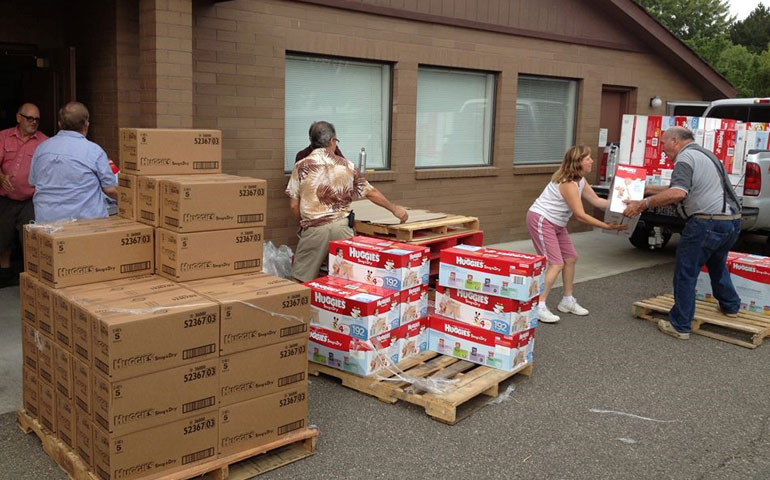
A dirty diaper most always elicits a reaction. In one case, dirty diapers led to the creation of the National Diaper Bank Network, a system of nonprofit groups that helps to provide about 98 million diapers annually to needy families who can't afford them.
About seven years ago, the Rev. Jim Swarthout, clergy community coordinator for Rosecrance Health Network and former pastor* of St. Paul's Episcopal Church in McHenry, Ill., was helping a young mother and her infant daughter in the church's food pantry. While holding the infant, Swarthout realized her diaper was full. He told the mother that the pantry had diapers; she then told Swarthout that she could only afford three diapers a day, and that government programs like the Supplemental Nutrition Assistance Program (SNAP) and Women, Infants, and Children (WIC) don't cover the purchase of diapers.
Swarthout investigated how low-income people could receive disposable diapers. Through an Internet search, he connected with Joanne Goldblum, a social worker in New Haven, Conn.
Goldblum, through home-based, clinical social work, discovered that many needy families are forced to reuse disposable diapers, a practice that is not healthy.
"I was struck by, over and over again, the lack of access to basic needs," Goldblum told NCR in a phone interview. "Not having toilet paper, garbage bags, diapers, feminine hygiene products, soap and shampoo. ... And I began to realize that there are certain things that need to be addressed before you can do any clinical work, that there's no clinical intervention for not having toilet paper."
Goldblum, her husband and some friends decided to start the Diaper Bank in 2004 in New Haven. They collected funds to buy and give away diapers. They received press for their work, which led to Swarthout contacting them for guidance and input. Goldblum provided Swarthout with templates for founding and maintaining his own diaper bank, St. Paul Diaper Bank Partners, which he operates out of his parish. He also reached out to McHenry's other denominations to help collect diapers.
"I have never seen something, in all my years of priestly ministry, break barriers between service agencies and churches," Swarthout said in a phone interview. "Catholic, Episcopalians, Lutherans, they all came together at the table when we really didn't have a clergy association."
In 2009, these diaper banks caught the attention of Huggies, an international diaper and wipes company. Huggies brought together Goldblum, Swarthout and eight others, representing 10 of the nation's first -- and potentially only -- diaper banks, to brainstorm about the need. After several meetings, they decided to start a national entity that could spread awareness. Huggies, Swarthout, Goldblum and the other diaper bank founders created the National Diaper Bank Network, which was incorporated in 2011 and has grown from a founding membership of 40 diaper banks to 195 today.
"The more we talked about it, the more we all worked together, the more we realized that there really needed to be a national entity to sort of drive this," said Goldblum, who serves on the network board and as executive director.
The growth of the network has led to greater awareness, with more people looking into diaper banks in their community and becoming more involved. Growth also meant the organization was recently able to purchase diapers at a considerably lower price.
"I think a large part of what has helped the network to grow so quickly is our reliance on grassroots efforts to raise awareness of diaper need, an issue directly related to poverty. Individuals are taking up the cause and making it their own," Goldblum wrote in an email to NCR. "The creation and support of diaper banks provides a concrete way to address a root problem in our society."
The network itself addresses the diaper need in three ways. They raise awareness among people who need help, potential volunteers and donors, and policymakers. They also provide technical assistance to diaper bank members by collecting and distributing best practices for running banks. And the network itself distributes diapers and funding to diaper banks, with 20 million diapers donated annually by Huggies.
Based on U.S. Census poverty stats, the National Diaper Bank Network estimates that 11 million children under 3 years old -- the network's target diaper-wearing population -- live in poverty. "If kids use eight to 10 diapers a day, you're talking about hundreds of millions of diapers," Goldblum said.
Goldblum encouraged those who want to help to host their own diaper drives. People can begin to address the need with small steps, "so, an individual who wants to do something can," Goldblum said.
Top 5 most needed nonfood items
NCR asked Kathleen DiChiara, founder, president and CEO of Community FoodBank of New Jersey, what the top five nonfood items that organizations like hers need. They include:
- Diapers (including for adults);
- Laundry soap;
- Toilet paper;
- Toothpaste;
- Sanitary napkins.
"Nonfood items sounds like something not essential," DiChiara said. "But if you stop and think: toilet paper, sanitary napkins, soap powder [laundry detergent], toothpaste. Those are essential. It's part of our culture that people have those products. I think for most Americans ... it never even occurs to them that these are things that so many people have to go without."
*An earlier version of this story misidentified Swarthout's title.
[Mick Forgey is an NCR Bertelsen intern. His email address is mforgey@ncronline.org.]



